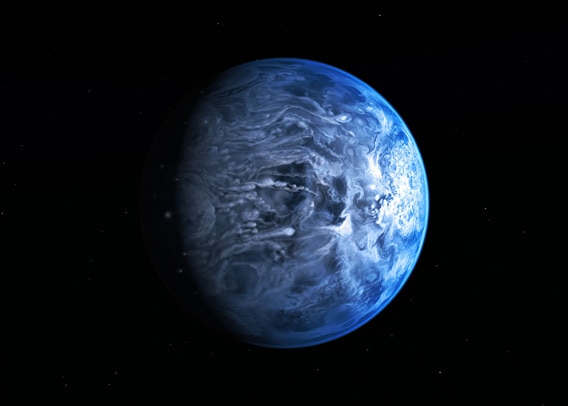Create a free profile to get unlimited access to exclusive videos, sweepstakes, and more!
The Deep Blue Color of an Alien World

HD 189733b is blue!
I know, right? Isnât that amazing? OK, maybe I better explain.
We now know of roughly 900 planets orbiting other stars. Theyâre found by lots of different methods, but the most successful way is the transit method: If we see the planetâs orbit edge-on, then it passes directly in front of its star once per orbit. It blocks a wee bit of the starâs light, and if you point a telescope at the star at the right time, you can measure that drop in light. Mind you, at these distances the planet is far, far too small to see directly (the picture at the top of this post is an artistâs illustration of the planet, not a photo). But thereâs a lot we can learn indirectly â¦
The star HD 189733 is about 63 light-years away and is actually a loose binary star, two stars orbiting each other. One is an orange dwarf, slightly smaller and cooler than the Sun, and the other is a red dwarf, much smaller and cooler than our star, orbiting the orange dwarf more than 30 billion kilometers away.
HD 189733b also orbits the orange star, but much closer in, only 4.6 million kilometers (about 3 million miles) away from the star. Every 2.2186 days (yes, days) it passes directly between us and the star, blocking a tiny bit of its light. That period is so short that we can observe a lot of these transits and build up quite a large amount of data. Over the years, weâve learned that the planet is roughly the mass of Jupiter (just 14 percent heftier), itâs a gas giant, and because itâs so close to its parent star, the temperature at the top of its clouds is more than 1,000 degrees Celsius (1,800 degrees Fahrenheit). Yikes.
Weâve also learned it has high windsâobservations of its ânight sideâ show that itâs far warmer than expected, meaning hot air from the star-blasted daylit side is being transported around to the dark side. Incredibly, detailed observations have detected the presence of methane, water (steam, really), sodium, and even indirect evidence of silicates.
And now we even know its color! Itâs blue. How was that done?
Astronomers used a camera called a spectrograph, which breaks up incoming light into its individual colors. This is very similar to taking the white light from the Sun, passing it through a prism, and seeing the spectrum of colors like a rainbow. The camera is called the Space Telescope Imaging Spectrograph, and itâs on the Hubble Space TelescopeâI will note with no small pride that I worked on STIS back in the day; I was on the team that calibrated and first used it when it was installed on Hubble in 1997. [preen]
The star HD 189733 was observed with STIS over and over again as the planet orbited it. Every time, the light was split into thousands of individual colors. What the astronomers found is that when the planet went behind the star, they saw less blue light, while all the other colors didnât change at all. The obvious conclusion is that the planet is very blue.
Mind you, being blue doesnât make it anything like Earth! Earth is blue because our air scatters the blue colors of incoming sunlight. Note that Neptune is also blue, but thatâs because it has a lot of methane in its air, which absorbs red light, leaving blue light to reflect back to our eyes. HD 189733b is most likely blue due to the silicates in its atmosphere that I mentioned above. Those scatter blue light.
So we have an interesting picture of this planet now. Itâs roughly the same size and mass as Jupiter. Itâs flippinâ hot, so hot that water in its atmosphere is in the form of steam, and drops of molten magnesium silicate may rain down. It has hellish winds, whipping the atmosphere into a frenzy (and probably driving that magnesium silicate rain sideways, not down). It withstands periodic outbursts from its parent star that can blow 1,000 tons of its atmosphere away every second. We even can figure out that it has lovely sunsets.
And itâs blue. Even from 630 trillion kilometers away, the color of this planet literally still shines through.
Itâs incredible what we can learn about our Universe simply by looking closely at it. It takes patience and sophisticated tech (STIS is a phenomenally complex and extraordinarily sensitive instrument), but mostly what it takes is imagination and the desire to learn. With all these advantages, it would be a crime not to try to understand the cosmos.


























